Tamami Tono, Composer and Shō Player
Performer of shō (a musical instrument of gagaku, Japanese ancient court music) and world-class composer
Her purpose in life since childhood has been “creation”
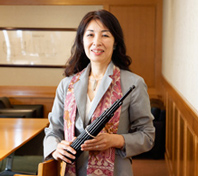
Tamami Tono,
Composer and Shō Player
Born in Takasaki City, Gunma Prefecture. After graduating from Takasaki Girl’s high school, Tono proceeded to the Kunitachi College of Music, where she majored in music composition and graduated with highest honors. In 1998, she obtained a master’s degree from the Graduate School of Media and Governance at Keio University. Since 1989, she has been participating in National Theatre performances as a shō player. She performs both at home and abroad, including the recital series, “Shō Universe.” She has also created many pieces as a composer, including “Hoshigatami” which won first place in the 2001 National Theatre Composition Concours, and “Gekkaraku ~Tsukishiro~,” a piece which she was commissioned by the National Theatre of Japan. She was also invited to join the Yo-Yo Ma Silk Road Project, and in 2011, she released a shō CD produced by Ryuichi Sakamoto titled “Breathing Media~Chōshi~,” which is the world’s premiere full recording of the ancient gagaku piece “Chōshi.” She is also a mother of two children.
Gagaku, ancient court music performed using instruments such as the shō, ryuteki and hichiriki, is the musical root for Japanese people
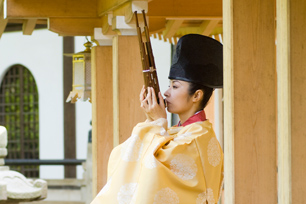
─ The shō is an instrument used in gagaku along with the ryuteki and hichiriki. It is a kind of a wind instrument, but looks very different from the flute or trumpet with its 17 thin bamboo tubes bundled together. The bamboo tubes are fitted with metal reeds, and when the musician breathes in or out of the mouthpiece causing the reeds to vibrate, that vibration resonates in the tubes. From this instrument comes unique music that sounds like it has come down from heaven.
Ms. Tamami Tono is both a shō player and a composer of modern gagaku. She is also a composer of computer music, which on the surface seems like the extreme opposite of gagaku. After graduating from the Kunitachi College of Music, Department of music composition, she completed the Graduate School of Media and Governance at Keio University.
We have the impression that gagaku musicians are born into families that have a long history with gagaku. Ms. Tono, please tell us about your encounter with Gagaku.
I was born in a family that had nothing to do with gagaku. However, I seemed to have had a strong interest in “creating something” since I was a child. Also, because I started to play the piano at age three, my creativity was expressed through music, and when I was around four years old, I would sing my own original lullabies to my baby brother when he was just born (laughs). The elementary school that I attended in Takasaki City was a progressive school that valued originality and creativity, as well as independence, and under these principles, when I was in third grade I composed a class song which I my classmates and I would sing every day at morning class meetings. After that, I sought a career as a composer, but if I had been good at drawing, I may have become an artist instead.
I became aware of gagaku in high school, when I clearly made up my mind to become a composer. This was because I thought that I should have a “mother tongue” in music, if I were to be involved in music as a Japanese person.
Our musical experience in Japan is greatly influenced by westernization policies after the Meiji Restoration and American culture after World War II. This is also quite clear considering that school music education is based on Western music rather than Japanese music (like koto or shamisen), and even I opened my eyes to music through my exposure to piano and pop music, which inspired me to start composing. However, I always felt that with knowledge only of Western music, I could not establish my identity as a Japanese musician, or show my originality as a composer.
─ It’s true that although we are familiar with music by Beethoven or Mozart, we hardly know anything about Japanese music before the Meiji era. As a Japanese person, I find this to be a little strange.
Exactly. This was the feeling I had when I entered the Kunitachi College of Music, where I majored in music composition. Back then, I sought the most advanced music and worked on composition using computers, but at the same time, I met Master Sukeyasu Shiba and Master Mayumi Miyata and started to learn gagaku seriously. Mr. Shiba is an expert player of the ryuteki, and having been brought up in a family of court musicians that stretches back 800 years, he belonged to the Music Department of the Imperial Household Agency as a court musician, and he used to teach at our university. On the other hand, there is Ms. Miyata who is also a graduate of the Kunitachi College of Music, majoring in piano at the Department of Music Performance. She is a world-class shō player, and had just started to teach at her alma mater.
Encountering gagaku through these two masters was a shocking experience for me, and it was not only about getting to know the musical roots of the Japanese people. One of the fundamental themes in computer music is to create and expand musical expressions that are not possible with musical instruments, but gagaku instruments can easily do that without a computer. For example, the shō can produce sounds of up to 60 kilohertz, and the amount of information from its sound has no comparison in Western musical instruments. As someone who was composing computer music which utilizes methods to electronically expand sound, I was really surprised that you can open up a wonderful acoustic world by just blowing your breath into the shō. I was touched by the beauty of the refined music of gagaku, and discovered the life within the “mastery of sound.”
This motivated me to devote my studies on gagaku and start off as a shō player.
SFC is full of curiosity and self-assurance, and makes you feel at home
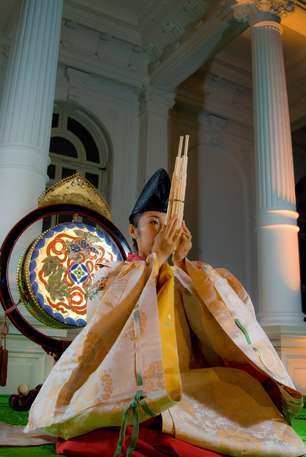
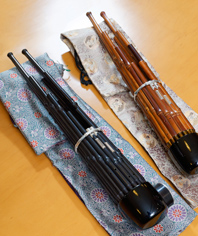
─ Why did you enter the Graduate School of Media and Governance at SFC after graduating from the Kunitani College of Music?
Although I chose music as my form of expression, my proposition was “what I can create as a creator.”
Therefore, I wanted to break free from the music college where all you learn is music, and enter a university where I can study a wide range of subjects, acquire a wide range of knowledge. I wanted to get an overview of music from a social standpoint and search for common ground with other forms of expression. I took the entrance exam of the Graduate School of Media and Governance because I heard that SFC was a place where teachers have various standpoints and values, and you could conduct exciting and interdisciplinary research.
Just as I had been told, there were teachers with different backgrounds, and those days were really exciting; taking classes on architecture and politics, and getting to see Professor Masaki Fujihata’s work on computerized visual art, which was leading-edge technology back then.
My mentor at SFC was Professor Toru Iwatake. Prof. Iwatake was working on a project to introduce traditional elements into computer music. He was creating computerized music based on the themes of Noh with Noh performers such as Mr. Hideo Kanze, and I joined in.
The wonderful thing about the graduate schools at SFC is that both teachers and students have their own field of expertise, so they respect each other through a collegial relationship rather than a superior-inferior relationship. The atmosphere of the campus, which was full of curiosity and eagerness to learn new things, made me feel at home. The reason I got to know Mr. Ryuichi Sakamoto, whom I worked with later on, was because some audacious junior students in the Professor Iwatake’s Laboratory invited Mr. Sakamoto to the campus.
My research theme centered on “breathing” and the shō, which is an instrument that produces sound when you breathe in and out, and how to utilize this breathing in modern technology. In my second year of the master’s program, I developed an original breath sensor with the support of a specialist. Turning the information obtained with the sensor into lights a graphics, the very act of “breathing” was transformed into a visual experience during the performance. Making visual images connect with my shō performance is a kind of extension of my physical expression. I also focused on creating sound using computers.
Why is music necessary in our society, and why do musicians exist? As a musician myself, seeking answers to these fundamental questions is an important task for me, and one of the answers is “breathing.” The trajectory of breathing becomes music. The trajectory itself may show the way of life of the performer. I see one aspect of the inevitability of music in the shō, which expands sound using breathing, through inhalation and exhalation. This research on breathing and music later led to the concept of “breathing media.”
─ Please tell us about winning the Keio President’s Honorable Award.
I received the President’s Honorable Award after my entry was accepted for the composition competition of the 1998 ICMC (International Computer Music Conference). In this piece, I used the computer to synthesize the sounds of the shō and the sounds created by rubbing and hitting charcoal from burnt woods (such as quercus phillyraeoides, a type of oak). The reason for using charcoal is because the shō needs to be warmed before playing it to create good sounds, and we use charcoal burnt in a brazier for that. When I say that I have used sounds produced by hitting charcoal, you may think I’m joking, but I tried to symbolize the deep relationship between the shō and charcoal. Creation may start from a playful mind.
I plan to continue shō performance as well as composing music. Today, I am also involved in composing music for the restored instruments that belong to the Shōsō-in, a treasure house in Todai-ji, Nara. This is a project which has been going on for about 30 years at the National Theatre, led by Mr. Toshiro Kido, who is also a graduate of Keio. I was able to learn many things through this project. The ancient musical instruments preserved at the Shōsō-in were once abandoned along with the Gagaku music. However, based on Mr. Kido’s proposal of “Tradition Creatrice” just like gagaku itself, modern composers have breathed new life into these original instruments that have been restored after some thousand years.
When we look back at the past several decades, this has been a time when not only music, but also culture and civilization developed greatly. In fact, the ivory shō which I have the honor of using in my performances is an ancient dream come true only because of advances in modern technology. Today, in a time where all kinds of new technologies, especially those related to information come and go, I would like to further pursue “substance,” because as a musician, I take pride in creating unique sounds and exquisite music.
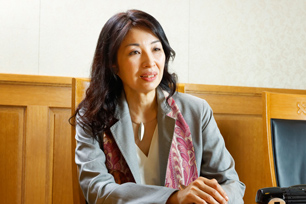
─ Could you give a message to current Keio University students?
There are many Keio graduates in my family, and they were really excited about this interview.
The spirit of “originality and creativity,” and independence, which was instilled in me since my elementary school days, are still mottoes that I live by today. I feel the traditional spirit of “independence” at the root of Keio’s educational philosophy. What makes Japan interesting is that it is a place where information, items, and phenomena from all around the world are brought together. This means that we need to have the skills to properly understand such information and make value judgments on our own when making decision and taking actions. To live in society, there are times when we have to be subordinate, but fundamentally, I would like you to maintain your independence to think and act for yourself.
─Thank you very much.
*Position titles, etc., are those at the time of publishing.
